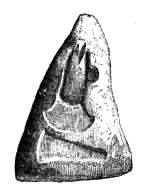Irish Butter and Cheese
It would appear that butter was also a plentiful product then as now. Specimens of bog butter are still preserved, and may be found in the collection of the Royal Irish Academy. The butter was thus entombed either for safety, or to give it that peculiar flavour which makes it resemble the old dry Stilton cheese, so much admired by the modern bon vivant. A writer in the Ulster Archaeological Journal mentions that he found a quantity of red cows' hair mixed with this butter, when boring a hole in it with a gouge. It would appear from this as if the butter had been made in a cow-skin, a fashion still in use among the Arabs. A visitor to the Museum (Mr. Wilmot Chetwode) asked to see the butter from Abbeyleix. He remarked that some cows' heads had been discovered in that neighbourhood, which belonged to the old Irish long-faced breed of cattle; the skin and hair remained on one head, and that was red. An analysis of the butter proved that it was probably made in the same way as the celebrated Devonshire cream, from which the butter in that part of England is generally prepared. The Arabs and Syrians make their butter now in a similar manner. There is a curious account of Irish butter in the Irish Hudibras, by William Moffat, London, 1755, from which it appears that bog butter was then well known:—
The butter was thus entombed either for safety, or to give it that peculiar flavour which makes it resemble the old dry Stilton cheese, so much admired by the modern bon vivant. A writer in the Ulster Archaeological Journal mentions that he found a quantity of red cows' hair mixed with this butter, when boring a hole in it with a gouge. It would appear from this as if the butter had been made in a cow-skin, a fashion still in use among the Arabs. A visitor to the Museum (Mr. Wilmot Chetwode) asked to see the butter from Abbeyleix. He remarked that some cows' heads had been discovered in that neighbourhood, which belonged to the old Irish long-faced breed of cattle; the skin and hair remained on one head, and that was red. An analysis of the butter proved that it was probably made in the same way as the celebrated Devonshire cream, from which the butter in that part of England is generally prepared. The Arabs and Syrians make their butter now in a similar manner. There is a curious account of Irish butter in the Irish Hudibras, by William Moffat, London, 1755, from which it appears that bog butter was then well known:—
"But let his faith be good or bad,
He in his house great plenty had
Of burnt oat bread, and butter found,
With garlick mixt, in boggy ground;
So strong, a dog, with help of wind,
By scenting out, with ease might find."
A lump of butter was found, twelve feet deep, in a bog at Gortgole, county Antrim, rolled up in a coarse cloth. It still retains visibly the marks of the finger and thumb of the ancient dame who pressed it into its present shape.
Specimens of cheese of great antiquity have also been discovered.
It was generally made in the shape of bricks,[9] probably for greater convenience of carriage and pressure in making. Wax has also been discovered, which is evidently very ancient. A specimen may be seen in the collection of the Royal Irish Academy. According to the Book of Rights, the use of wax candles was a royal prerogative:—
"A hero who possesses five prerogatives,
Is the King of Laighlin of the fort of Labhraidh:
The fruit of Almhain [to be brought to him] to his house;
And the deer of Gleann Searraigh;
To drink by [the light of] fair wax candles,
At Din Riogh, is very customary to the king."[1]
In this matter, at least, the Irish kings and princes were considerably in advance of their Anglo-Saxon neighbours. Wright informs us [2] that their candle was a mere mass of fat, plastered round a wick, and stuck upon an upright stick: hence the name candlestick.
Notes
[9] Bricks.—In an ancient life of St. Kevin of Glendalough, there is mention made of certain brick-cheeses, which the saint converted into real bricks, in punishment to a woman for telling a lie.
[1] King.—Book of Rights, p. 15.
[2] Informs us.—Domestic Manners, p. 43.
